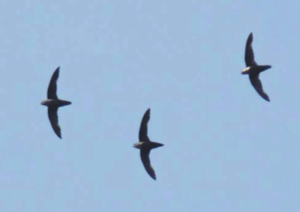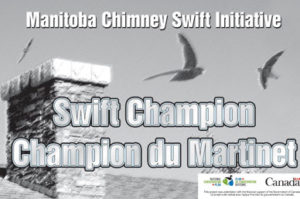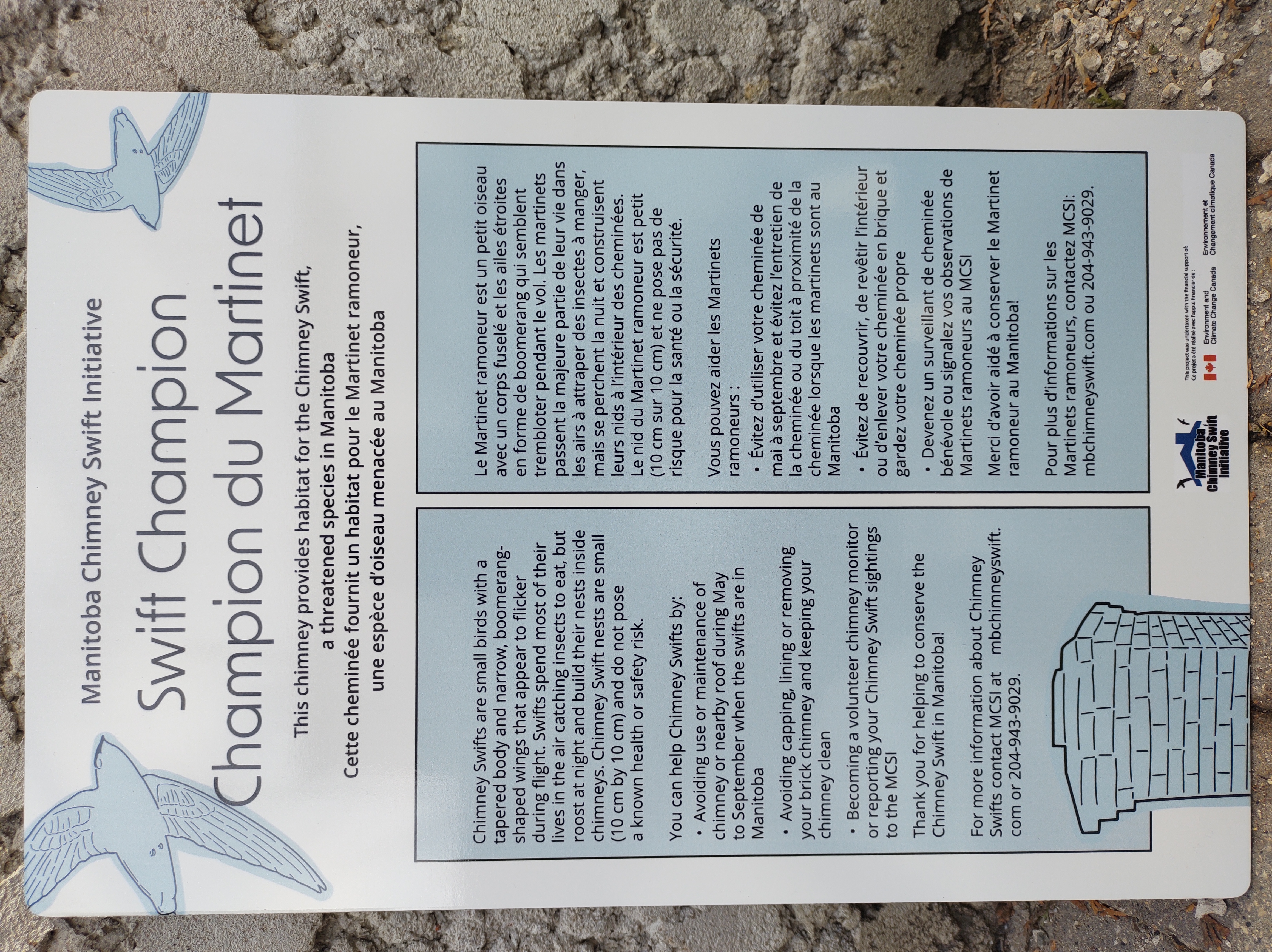Become a Chimney Swift Champion!

The Canadian Chimney Swift population has decreased by about 95% in the last 40 years. While there are many possible reasons for the decline of Chimney Swifts, including insect availability and extreme weather events.
One of the main factors is a dramatic reduction in the number of “swift-friendly” chimneys. Chimney Swifts are protected under federal and provincial Species at Risk legislation. This means it is an offence to kill or injure individuals or destroy the habitat on which they rely.
Chimney Swift Conservation
If your home, business or institution has a large-diameter (minimum 2.5 bricks by 2.5 bricks wide), unlined and uncapped, rough interior chimney it may be suitable for Chimney Swifts. Chimney Swifts are in Manitoba from mid-May until late August. Since most chimneys are not in use for heating purposes during this time, swifts and building owners can easily share the chimney. Swift nests are tiny so they pose no fire hazard.
Some things you can do, or avoid doing, to help our Chimney Swifts:
Clean your chimney regularly. A clean interior wall will help the nest remain attached throughout the nesting period. Regular cleaning of an active chimney reduces the risk of creosote accumulation and a flue fire. A one-time cleaning of an inactive chimney will restore the interior surface to a swift-friendly condition.
Clean between September and April when swifts are not present.
Repair rather than demolish. If you are concerned about structural deterioration your chimney, consider repairing it. Contact MCSI for information on potential funding.
Refrain from using your fireplace/heating system chimney from mid-May to late August. Fumes can be fatal to swift adults or young.
Avoid disturbance. Keep the cleanout trap closed and avoid looking down the chimney or renovating the roof from mid-May until the end of August.
Manage the noise. Nestlings greet adults bringing them food; the sounds may seem boisterous for about two weeks. Muffle noise by closing the damper tightly and packing temporary insulation inside. Remove the insulation in the fall before using the chimney again.
Seal off access to the chimney inside the house during the breeding season. This will prevent swifts from entering the rest of your building bchimney can still be cleaned during the remainder of the year.
Limit closures. Ensure the chimney remains available for the birds (avoid capping it or lining it with sheet metal). If your building has two chimneys which you have decided to line and cap, consider leaving one unmodified for use by swifts.
Prevent access to lined chimneys by capping. Thus preventing swifts and other wildlife from entering and becoming trapped inside.
Avoid over-pruning trees or large shrubs on your property. While flying by, Chimney Swifts break off the tips of dead branches for nest building.
Advocate wetland protection. Wetlands are important sources of the swift’s favourite food – flying insects. Remember, Chimney Swifts consume over I ,OOO mosquitoes and other flying insects per day.
Become citizen scientists. MCSI needs new volunteers. Count the number of swifts entering your chimney at dusk during the nesting/roosting season, and submit results to MCSI.
Contact the MCSI. If you see Chimney Swifts or know where they are nesting or roosting, please contact MCSI for more specific information and advice.
Becoming a Chimney Swift Champion

Chimney Swifts need your help. If you have or suspect Chimney Swifts are using a chimney in your school, church, business, apartment or home or if you wish to help MCSI monitor roost and nest sites, then please consider becoming a Chimney Swift Champion.
Chimney Swift Champions agree to (all or some):
- Partner with the Manitoba Chimney Swift Initiative in conserving these Manitoba Chimney Swift Initiative special birds.
- Protect the Chimney Swifts: avoid using your chimney and unnecessary access of your roof from May to August; watch the birds from the ground and not from above or the clean-out trap.
- Maintain the chimney: do not cap, line or deconstruct; keep it clean (clean only between September and April); ensure the clean-out trap is closed.
- Consider monitoring nesting or roosting Chimney Swifts in your area or allow an MCSI monitor to view your chimney occasionally.
- Survey a group of chimneys on behalf of MCSI.
- Conserve trees on your property and advocate for wetland conservation near your home.
LANDOWNER AND VOLUNTEER AGREEMENTS
Why not formalize your commitment to the project by signing a Landowner or Volunteer participation agreement?
Swift Champions Agreement for Landowner Partners
Swift Champions Agreement for Individuals
Factsheet #3: ‘Become a Chimney Swift Champion’. View and print our suggestions to ‘champion’ the conservation of Chimney Swifts as home or business owners and/or volunteers. Version française
RECIPIENTS OF SWIFT CHAMPION AWARDS
Follow the links to learn more about recipients of our Chimney Swift Champions awards:
Individual and Group Champions:
- Ron Bazin
- Providence University College & Theological Seminary
- Garry Budyk
- Barbara & Phil Barnett
- Luc Blanchette
- Gerald Machnee
- Katharine Schulz
- Blair Reid
- Westman Naturalists
- Assiniboine Park Conservancy
- Lagasse’s Studio of Fine Art (Souris)
- The Orange Block (Brandon)
- Maryland Foodfare
- Shawn Charlebois
- The Smith Agency
- Joanne Tuckwell
- Nicole Firlotte
- Guent Salzmann
- House of Hesed
- Rhonda and Craig Baxter
- Margaret Yorke and Millie Reid
- Christian Artuso
- Gord Ogilvie
- John Hays
- St Norbert Behavioural Health Foundation
- John Howard Society
- Red River College
- David Dawson
- Crystal Dalgleish
- Selkirk Birdwatching Club
- Adolph Ens and David Wiebe
- Ed Loewen
- Lewis Cocks
- Jan and Ken Wainwright
- Paroisse St Adolphe
- The Municipality of Ritchot
- Lee Doerksen CBC story with video
- Suzanne and Arthur Leclerc
- Barb and Rob Stewart
- Frank Machovec
Champion Sites:
- Watson Art Centre, Dauphin
- Roxy Lanes, Winnipeg
- Trinity United Church, Portage La Prairie
- Souris United Church, Souris
- St Mary’s Road United Church, Winnipeg
- St Joachim Catholic Church, La Broquerie
- Kowalchuk Funeral Home, Souris
- My Place Realty, Winnipeg
- Merchant Hotel, Selkirk
- St Avila School, Winnipeg
- Good News Fellowship Church, Winnipeg
- St Ann’s Catholic Church, Winnipeg
- St Jean-Baptiste Parish Church

For more information:
Our project coordinator may be contacted at mbchimneyswift@gmail.com or by phoning the Nature Manitoba office at 204 943-9029
